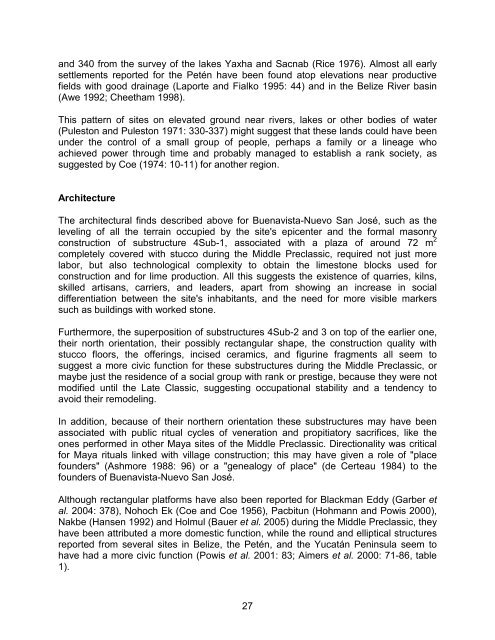Buenavista-Nuevo San José, Petén, Guatemala: Another ... - Famsi
Buenavista-Nuevo San José, Petén, Guatemala: Another ... - Famsi
Buenavista-Nuevo San José, Petén, Guatemala: Another ... - Famsi
Create successful ePaper yourself
Turn your PDF publications into a flip-book with our unique Google optimized e-Paper software.
and 340 from the survey of the lakes Yaxha and Sacnab (Rice 1976). Almost all early<br />
settlements reported for the <strong>Petén</strong> have been found atop elevations near productive<br />
fields with good drainage (Laporte and Fialko 1995: 44) and in the Belize River basin<br />
(Awe 1992; Cheetham 1998).<br />
This pattern of sites on elevated ground near rivers, lakes or other bodies of water<br />
(Puleston and Puleston 1971: 330-337) might suggest that these lands could have been<br />
under the control of a small group of people, perhaps a family or a lineage who<br />
achieved power through time and probably managed to establish a rank society, as<br />
suggested by Coe (1974: 10-11) for another region.<br />
Architecture<br />
The architectural finds described above for <strong>Buenavista</strong>-<strong>Nuevo</strong> <strong>San</strong> <strong>José</strong>, such as the<br />
leveling of all the terrain occupied by the site's epicenter and the formal masonry<br />
construction of substructure 4Sub-1, associated with a plaza of around 72 m 2<br />
completely covered with stucco during the Middle Preclassic, required not just more<br />
labor, but also technological complexity to obtain the limestone blocks used for<br />
construction and for lime production. All this suggests the existence of quarries, kilns,<br />
skilled artisans, carriers, and leaders, apart from showing an increase in social<br />
differentiation between the site's inhabitants, and the need for more visible markers<br />
such as buildings with worked stone.<br />
Furthermore, the superposition of substructures 4Sub-2 and 3 on top of the earlier one,<br />
their north orientation, their possibly rectangular shape, the construction quality with<br />
stucco floors, the offerings, incised ceramics, and figurine fragments all seem to<br />
suggest a more civic function for these substructures during the Middle Preclassic, or<br />
maybe just the residence of a social group with rank or prestige, because they were not<br />
modified until the Late Classic, suggesting occupational stability and a tendency to<br />
avoid their remodeling.<br />
In addition, because of their northern orientation these substructures may have been<br />
associated with public ritual cycles of veneration and propitiatory sacrifices, like the<br />
ones performed in other Maya sites of the Middle Preclassic. Directionality was critical<br />
for Maya rituals linked with village construction; this may have given a role of "place<br />
founders" (Ashmore 1988: 96) or a "genealogy of place" (de Certeau 1984) to the<br />
founders of <strong>Buenavista</strong>-<strong>Nuevo</strong> <strong>San</strong> <strong>José</strong>.<br />
Although rectangular platforms have also been reported for Blackman Eddy (Garber et<br />
al. 2004: 378), Nohoch Ek (Coe and Coe 1956), Pacbitun (Hohmann and Powis 2000),<br />
Nakbe (Hansen 1992) and Holmul (Bauer et al. 2005) during the Middle Preclassic, they<br />
have been attributed a more domestic function, while the round and elliptical structures<br />
reported from several sites in Belize, the <strong>Petén</strong>, and the Yucatán Peninsula seem to<br />
have had a more civic function (Powis et al. 2001: 83; Aimers et al. 2000: 71-86, table<br />
1).<br />
27
















